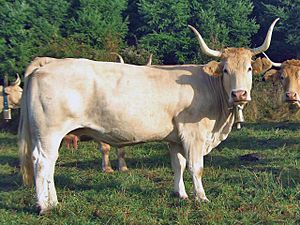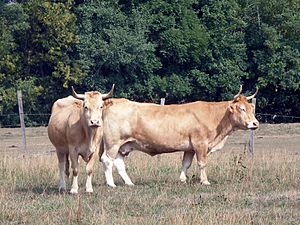Pirenaica facts for kids

|
|
| Conservation status | FAO (2007): not at risk |
|---|---|
| Other names | Basque: Behi-gorri |
| Country of origin | Spain |
| Distribution | northern Catalonia |
| Standard | Confederación de Asociaciones de Ganado Vacuno Pirenaico (in Spanish) |
| Use | Mainly meat |
| Traits | |
| Weight |
|
| Height |
|
| Coat | wheaten |
| Horn status | horned |
|
|

The Pirenaica (pronounced Pee-reh-NAY-kah), also known as Behi-gorri in the Basque language, is a special type of beef cattle. This breed comes from the Pyrenees mountains in north-eastern Spain. You'll mostly find these cows in areas like Navarre and the Basque Country, but they live across much of northern Spain.
These cows are very good at living in mountainous areas with lots of rain. They almost disappeared in the 1900s, but thankfully, they are now safe and not at risk of extinction.
Contents
The History of Pirenaica Cattle
The exact beginnings of the Pirenaica breed are not fully known. In the past, these cows were very common in northern Spain. To keep track of them, a special "herd book" was started in Gipuzkoa in 1905. This was the first book of its kind for cattle in Spain! Another herd book was opened in Navarre in 1925.
A Close Call with Extinction
Around the early 1900s, farmers started bringing in many Braunvieh cattle from Switzerland. These new cows were sometimes mixed with Pirenaica cows. This was done to try and get more meat and milk from the animals.
By 1912, a count in Gipuzkoa showed that less than 40% of the cows were pure Pirenaica. The rest were Braunvieh or a mix of both breeds. This mixing continued, and by the 1970s, the Pirenaica breed was almost gone. In 1974, there were only about 40 Pirenaica cows left in the Basque Country. In Navarre, about 1,500 remained.
Bringing the Breed Back
Luckily, in the 1970s, a group in Navarre called the Diputación Foral started a plan to save the Pirenaica breed. Farmers created local groups to help. In 1988, these groups joined together to form a national organization.
Thanks to these efforts, the number of Pirenaica cattle grew a lot! By the end of 2014, there were over 40,000 Pirenaica cows and bulls. About half of them lived in Navarre, and a quarter were in the Basque Country. Smaller groups were found in other parts of Spain too.
Today, the Spanish Ministry of Agriculture says that the Pirenaica is an "autochthonous breed in development." This means it's a native breed that is growing and no longer in danger of disappearing.
How Pirenaica Cattle Are Used
In the past, Pirenaica cattle were used for three main things:
- As draught animals: This means they pulled carts or farm equipment.
- For milk production: They provided milk.
- For meat production: They were raised for their meat.
Today, farmers mostly raise Pirenaica cattle for their meat. However, sometimes the male Pirenaica oxen are still used in a traditional sport called arrastre de piedra. In this sport, the strong oxen pull heavy stones.
See also
 In Spanish: Pirenaica (raza bovina) para niños
In Spanish: Pirenaica (raza bovina) para niños

